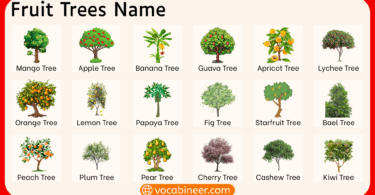Root vegetables grow underground and store nutrients for the plant. People eat them in many parts of the world. From crunchy carrots to starchy potatoes, they come in many shapes, colors, and textures. This guide helps you learn English names for common and rare root vegetables using pictures and short descriptions. These words are useful when reading recipes, cooking, or shopping in English.
In This Page
What Are Root Vegetables?
Root vegetables are the parts of plants that grow below the surface of the soil. They include roots, tubers, and bulbs. These underground parts store energy and nutrients for the plant and are often rich in vitamins, fiber, and starch. Many root vegetables are used in daily cooking around the world, either raw, roasted, boiled, or fried. Common examples include carrots, potatoes, onions, and radishes.
List of Root Vegetables with Pictures for Easy Learning
Below is a complete list of root vegetables in English to help you learn their names and recognize them easily.
- Arrowroot
- Beetroot
- Burdock Root
- Carrot
- Cassava
- Celeriac (Celery Root)
- Chicory Root
- Dandelion Root
- Galangal
- Garlic
- Ginger
- Ginseng Root
- Horseradish
- Jicama
- Jerusalem Artichoke
- Kohlrabi
- Licorice Root
- Lotus Root
- Malanga
- Onion
- Parsnip
- Potato
- Purple Sweet Potato
- Radish
- Skirret
- Sweet Potato
- Taro Root
- Turnip
- Turmeric Root
- Wasabi Root
- Yam

Common Root Vegetables Names in English
These root vegetables are commonly used in cooking around the world. They grow underground and store energy in the form of starch or sugar. Knowing these names helps you read recipes, shop at markets, and talk about food in English.
- Carrot – Orange, crunchy, and sweet. Often eaten raw or cooked.
- Potato – Starchy and soft when boiled, fried, or baked.
- Sweet Potato – Sweeter than regular potatoes, with orange or purple flesh.
- Beetroot – Deep red color, earthy flavor, used in salads and soups.
- Radish – Small, spicy, and often eaten raw in salads.
- Turnip – White and purple skin, used in soups or roasted dishes.
- Parsnip – Looks like a white carrot but has a sweeter taste.
- Onion – Adds flavor to many dishes, used chopped or cooked.
- Garlic – Strong flavor, used in small amounts for seasoning.
- Ginger – Spicy and aromatic, used in teas and Asian recipes.
- Taro – Starchy root with purple specks, common in tropical cuisine.
- Cassava – Also called yuca; a thick root used in many African and Latin American dishes.
- Daikon – A long white radish from East Asia, mild and juicy.
- Yam – Similar to sweet potato but usually drier and starchier.
- Horseradish – Pungent root often used as a spicy condiment.
Names of Edible Roots Used in Cooking
These edible roots are widely used to flavor, thicken, or enrich meals in different cuisines. Many are also valued for their aroma, color, or health benefits. Learning their names helps in understanding recipes and food labels.
- Carrot – Sweet and orange, used in salads, soups, and baking.
- Ginger – Spicy and warm, used in stir-fries, curries, and teas.
- Turmeric – Bright yellow root used in Indian and Middle Eastern dishes.
- Garlic – Sharp and pungent, used to flavor almost all savory dishes.
- Onion – Adds depth to soups, sauces, and roasted meals.
- Sweet Potato – Common in baking, roasting, and desserts.
- Potato – Used in mashed, fried, or baked dishes worldwide.
- Cassava – Starchy and fibrous, often used in flour or fried.
- Beetroot – Adds deep color and mild sweetness to dishes.
- Horseradish – Grated into sauces for a spicy kick.
- Parsnip – Nutty and sweet, often roasted or mashed.
- Taro – Creamy when cooked, used in savory and sweet dishes.
- Radish – Eaten raw or lightly cooked, peppery in flavor.
- Lotus Root – Crunchy and slightly sweet, popular in Asian cooking.
- Wasabi Root – Grated to make the spicy green Japanese condiment.
Medicinal and Herbal Root Vegetables Types
Some root vegetables are not just food — they are also used in herbal medicine and traditional healing. These roots are known for their health benefits, such as improving digestion, boosting immunity, or reducing inflammation.
- Ginger Root – Fights nausea and helps with colds and digestion.
- Turmeric Root – Used for its anti-inflammatory and antioxidant properties.
- Garlic Bulb – Supports heart health and strengthens the immune system.
- Horseradish Root – Clears sinuses and helps relieve respiratory discomfort.
- Licorice Root – Used in herbal teas for sore throat and stomach relief.
- Ginseng Root – Boosts energy and is used in traditional Asian medicine.
- Burdock Root – Known for blood purification and skin detox support.
- Dandelion Root – Often used as a liver tonic and mild diuretic.
- Ashwagandha Root – An adaptogen that helps reduce stress and anxiety.
- Maca Root – Found in powder form, supports stamina and hormonal balance.
- Galangal Root – Similar to ginger, used in Thai cooking and for digestion.
- Yellow Dock Root – Used in herbal blends to support digestion and skin.
- Valerian Root – Taken as a calming tea or supplement to support sleep.
- Angelica Root – Used in traditional medicine for coughs and cramps.
Root Vegetables Names by Color and Texture
These groups help describe how root vegetables look and feel:
White or Pale Roots:
- Potato
- Parsnip
- Celeriac
- White Radish
Red or Purple Roots:
- Beetroot
- Purple Sweet Potato
- Red Onion
Starchy or Dry Roots:
- Yam
- Cassava
- Taro
Spicy or Strong Roots:
- Horseradish
- Ginger
- Garlic
Leafy Type Root Vegetables (with Edible Leaves)
Some root vegetables offer double value — you can eat both the root and the leafy green tops. These are rich in vitamins and fiber and used in many healthy dishes, from soups to sautés.
- Beetroot – The red root is sweet, and the beet greens are cooked like spinach.
- Turnip – The white-purple root is used in stews, and turnip greens are sautéed or boiled.
- Radish – The crunchy root is eaten raw, while radish leaves can be used in stir-fries.
- Carrot – The orange root is common in meals, and the leaves can be added to pesto or soups.
- Sweet Potato – The tuber is popular in baking, and the leafy tops are eaten in many tropical cuisines.
- Cassava (Yuca) – The root is starchy, and cassava leaves are cooked well to remove toxins.
- Taro – The root is creamy when cooked, and the leaves are used in dishes like “luau” after boiling.
- Mustard Root (young mustard plant) – The roots can be pickled, and the spicy greens are cooked or eaten raw.
- Yam – Some yam varieties have edible leaves used in stews, especially in West African dishes.
Rare and Regional Root Vegetables List
These are less common root vegetables but are still used in certain countries or cultures:
- Kohlrabi
- Malanga
- Arrowroot
- Jicama
- Skirret
- Wasabi Root
A to Z Chart of Root Vegetables Names
A quick alphabetical list to help you learn or revise the names:
- Arrowroot
- Beetroot
- Burdock Root
- Carrot
- Cassava
- Celeriac
- Chicory Root
- Dandelion Root
- Galangal
- Garlic
- Ginger
- Ginseng Root
- Horseradish
- Jicama
- Jerusalem Artichoke
- Kohlrabi
- Licorice Root
- Lotus Root
- Malanga
- Onion
- Parsnip
- Potato
- Purple Sweet Potato
- Radish
- Skirret
- Sweet Potato
- Taro Root
- Turnip
- Turmeric Root
- Wasabi Root
- Yam
FAQs About Root Vegetables Names
Roots grow downward from the plant and absorb nutrients, while tubers store energy and are usually thick, underground stems.
Carrots, sweet potatoes, beets, and garlic are rich in fiber, vitamins, and antioxidants.
Yes, some like carrots, radishes, and beets can be eaten raw, but others like cassava or taro must be cooked.
Yes, they are considered bulb root vegetables and are part of the allium family.
Ginger, turmeric, ginseng, and dandelion root are commonly used in herbal remedies.
Read More




